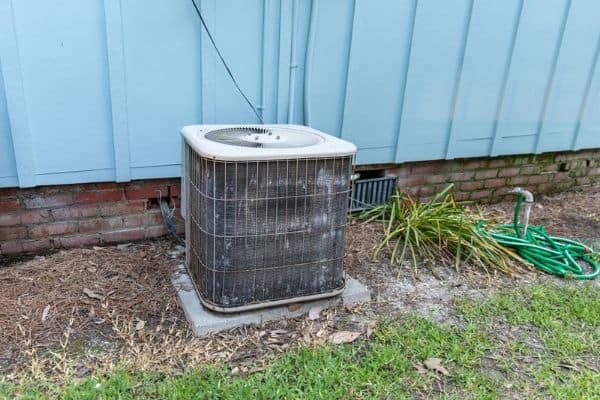What is SEER?
Before we can explain what 19 SEER means, let’s introduce the concept of SEER first. SEER stands for Seasonal Energy Efficiency Ratio and is a measure of how efficiently an air conditioner converts electrical power into cooling power. In simple terms, it is how much cold air is produced versus the electricity used.
Larger SEER ratings mean the air conditioner has higher efficiency. For example, 19 SEER AC units have better efficiency than 16, 17, and 18 SEER rated AC systems.
With that said, a 16 SEER air conditioner could provide the same amount of cooling output as a 19 SEER air conditioner. However, the 16 SEER unit would use much more energy to so.
Every new air conditioner has a SEER rating and they are an easy way to compare the energy efficiency of different AC systems. Higher SEER ratings use less energy and will leave you with less money due when the electricity bill comes around.
So What Does 19 SEER Mean?
Like any other SEER rating, 19 SEER represents the ratio of the AC unit’s total seasonal cooling output to the total electricity it uses throughout the entire cooling season.
The SEER rating is provided as a specification by the manufacturer and is entirely determined by them and will never be something you have to test for yourself.
AC units with a 19 SEER rating almost always include a variable speed compressor and a variable-speed blower.
These variable-speed components have much better efficiencies than single-stage and two-stage blowers and compressors found on lower-rated SEER units.
Is 19 a Good SEER Rating?
Air conditioners that have a 19 SEER rating are considered fantastic! Almost all HVAC experts will agree that 19 is by far an above-average, high SEER rating for central air conditioners, air-source heat pumps, and more.
Compared to the minimum SEER ratings allowed by the U.S. Department of Energy (13 and 14 SEER units), 19 SEER is a significant improvement.
However, because of the higher upfront cost that 19 SEER AC units command, they are not as popular for homeowners.
Although 19 SEER is only marginally higher priced than, say, a comparable 15, 16, or 17 SEER system, some homeowners opt for the lower upfront cost of a lower SEER system instead of the potential energy savings a 19 SEER unit would provide.
What Do 19 SEER Air Conditioning Units Cost?
Air conditioning systems vary widely in cost. With thousands of different models, hundreds of brands, and a handful of different types of cooling systems, you can quickly end up in a deep sea of air conditioners with no idea which one to choose.
However, you’ve narrowed down a step since you might have already decided to go with a 19 SEER air conditioner by this point! That’s great because it is one of the critical factors related to the cost of a new AC unit.
The other cost factors relate primarily to the size of the air conditioner (measured in tons or British thermal units [BTUs]) and the type (central AC, window air conditioner, ductless mini-split, etc.).
The Costs of 19 SEER Air Conditioners
19 SEER AC units tend to be on the pricier side than SEER units from 13-18 ratings. The more advanced technology ( variable-speed blowers and compressors) used in 19 SEER air conditioners are the main driver for their increased costs.
Although 19 SEER air conditioners cost more, they will save you money on your electricity bill each month.
Here’s exactly how much various 19 SEER air conditioning systems cost on average:
3-ton (36,000 BTU) Central Air Conditioner
- $3800
3-ton Air-Source Heat Pump
- $4300
9,000 BTU (0.75-ton) Ductless Mini-Split Heat Pump
- $800
Yearly Electricity Costs of 19 SEER Air Conditioners
Finding out exactly how much it costs to run a 19 SEER air conditioner is relatively easy. However, it does take a bit of simple math to do. So open the calculator app on your phone to follow along (or don’t).
To do this calculation, you’ll need to know the following information. Here are some hypothetical values for the sake of this example:
- 19 SEER rating
- 36,000 BTU/hr (3 ton)
- Local electricity cost: $0.25 per kilowatt-hour (kWh)
- 105 day cooling season
- 11 hour a day usage
To find the electricity costs, first, we need to find the power in kilowatts (kW) of the air conditioner with the following math, divide the BTU/h by the SEER rating:
36,000 BTU/h / 19 SEER = 1895 watts or 1.895 kilowatts (kW)
Next, to get the cost per year, multiple the kW by the local electricity cost, days, and hours!
1.895 kW X $0.25 per kWh X 105 days X 11 hours =$547.18 per year
As we have shown, a large 3-ton central air conditioner is pretty inexpensive to run each year! A cost of $547.18 per year equates to about only $46 per month.
You can do this same math for your 19 SEER AC unit too! Just determine all the variables in the bulleted list above and plug your numbers into the two equations – easy-peasy!
How Do 19 SEER AC Unit Costs Compare to Lower SEER Ones?
Yes, we know that 19 SEER units cost more than their lower SEER rated siblings. But how much more? And are the energy savings worth the extra upfront costs?
Let’s dive in and find out!
We’ll use a 3-ton central air conditioner with various SEER ratings for an average price comparison as a benchmark:
- 19 SEER: $3,200
- 18 SEER: $2,600
- 17 SEER: $2,400
- 16 SEER: $1,950
- 15 SEER: $1,850
So, an $800 difference between a 19 SEER and 17 SEER unit is pretty significant. The price difference between a 19 SEER and 15 SEER AC unit is even more substantial at $1,350.
Here’s how the estimated yearly electricity costs compare between 15, 17, and 19 SEER (using the same calculations and assumptions in the previous section):
- 15 SEER: $693.00 electricity cost per year
- 17 SEER: $611.47 electricity cost per year
- 19 SEER: $547.18 electricity cost per year
As you can see, a 19 SEER unit provides a 21% energy cost reduction compared to a 15 SEER air conditioner of the same cooling capacity.
However, since energy costs are so low, it would take several years for these yearly energy cost savings to “break even” with the extra money spent upfront.
To elaborate, the 19 SEER unit costs $3,200, and the 15 SEER unit costs $1,850 upfront. The 19 SEER air conditioner saves you electrical costs of $145.82 per year ($693 minus $547.18). Therefore, it would take about 12.7 years for the $145.82 savings per year to equal $1850.
However, this estimate is assuming energy costs will remain constant. They’re more than likely to increase, which would get you to the break-even point sooner.
What Should You Know About SEER in AC Units?
It should be clear to you by now that SEER ratings are one of the most crucial aspects of any air conditioner. The core concepts of SEER ratings that you should know are:
- Higher SEER AC units are more energy efficient
- Higher SEER units use less electricity and lower your energy bills
- Higher SEER air conditioners cost more upfront
- Higher SEER air conditioning systems provide more even cooling to your home, minimizing “hot spots” and “cold spots”
These four core concepts are really what you should be considering when selecting a SEER rating on a new air conditioner for your home.
How Do You Find the SEER Rating of an Air Conditioning System?
SEER ratings of all new air conditioners can be easily found on their Energy Guide tags or stickers. If you’re shopping in a retail store, these tags aren’t hard to find. They are bright yellow and are made by the Energy Star agency.
If you’re looking at air conditioners online, you’ll likely not see an Energy Guide tag. Instead, the SEER rating is usually in the product title, and you’ll have to look no further than the name.
SEER vs EER and COP Ratings
SEER isn’t the only type of energy efficiency out in the wild. While you’re on the hunt for a 19 SEER air conditioner, you may run into EER and COP ratings too. You’ll probably see these on the Energy Guide tags:
- COP: Coefficient of Performance
- EER: Energy Efficiency Ratio
COP only applies to heat pumps, like ductless mini-split and air-source heat pumps that provide both heating and cooling to your home.
EER differs from SEER because it is the efficiency of an air conditioner measured at only the outdoor temperatures of 95°F (35°C).
All three ratings – SEER, EER, and COP have better efficiency ratings with higher numbers.
EER can be estimated into a SEER rating by dividing by 0.875. For example, 16.625 EER times 0.875 equals 19 SEER. This 0.875 relationship is just a quick trick and is not 100% accurate.
Why Does AC Unit Size Matter When Choosing A SEER Rating?
Sure, SEER is arguably the most crucial aspect of an air conditioner, but AC unit size is just as important.
AC unit size refers to the cooling capacity of the air conditioner, which is measured in both tons (tonnage) and BTUs (British thermal units). One ton equals 12,000 BTUs.
The reason AC size is so important is if you get an air conditioner with too little cooling capacity, you’ll never be able to cool your home correctly.
Therefore, when you choose your 19 SEER air conditioner, make sure you get one that’s not too small, not too big, but just right!
Don’t stress about AC size – our HVAC professional can size an AC unit for your home based on its square footage or by doing what’s called a Manual J calculation.
What Should You Look For In An HVAC Specialist?
Our HVAC specialists are seasoned and knowledgeable with everything to do with air conditioners, heaters, and heat pumps.
Our experts can show you different brands of air conditioners, different sizes, and types of AC units. They can help explain the differences between SEER and EER and COP ratings too.
If you’re scratching your head about 19 SEER ratings, air conditioner sizes, and the various types of AC systems – you should give us a call. We can explain everything in easy-to-understand terms and guide you to the right solution for your home.









